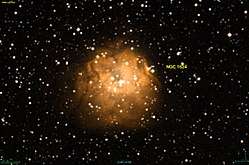NGC 1624
NGC 1624 is a very young open cluster located in the constellation Perseus inside an emission nebula. It was discovered by the German-British astronomer William Herschel in 1790.[3] NGC 1624 is located at about 20,000 ly (6,000 pc) away and the latest estimates give an age of less than 4 million years.[2] The apparent magnitude is 11.8,[1] and apparent diameter is about 3.0 arc minutes.[3] Its celestial location is right ascension (α) 04h 40m 36.0s and declination (δ) +50° 27′ 42″.[1]
| NGC 1624 | |
|---|---|
 Image of NGC 1624 Credit: DSS | |
| Observation data (J2000 epoch) | |
| Constellation | Perseus |
| Right ascension | 04h 40m 36.0s[1] |
| Declination | +50° 27′ 42″[1] |
| Distance | 20000 ± 2000 ly (6000 ± 600 pc[2]) |
| Apparent magnitude (V) | 11.8[1] |
| Physical characteristics | |
| Estimated age | <4 Myr[2] |
| Other designations | Cr 53, C 0436+503, OCl 403 |
According to Robert Trumpler's classification of open clusters, this cluster contains less than 50 stars (letter p) with a high concentration (I) and whose magnitudes are distributed over an average interval (number 2). The letter n at the end (I2pn) means that the cluster is inside a nebula.
References
- "NGC 1624". SIMBAD. Centre de données astronomiques de Strasbourg. Retrieved 9 November 2017.
- "Sejong Open Cluster Survey (SOS) - IV. The Young Open Clusters NGC 1624 and NGC 1931". SIMBAD. Centre de données astronomiques de Strasbourg.
- Seligman, Courtney. "New General Catalogue objects: NGC 1600 - 1649". cseligman.com. Retrieved 9 November 2017.
External links

- NGC 1624 spider.seds.org
- NGC 1624
- Sharpless Catalogue